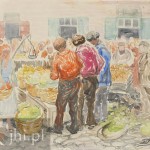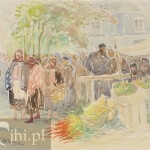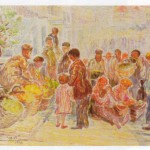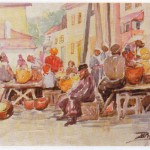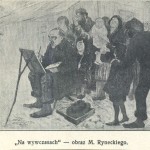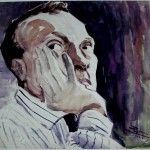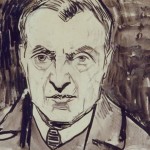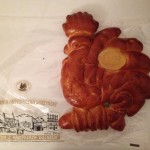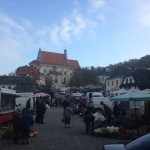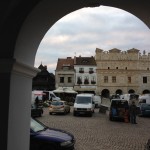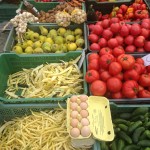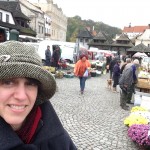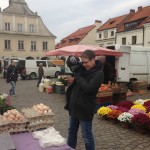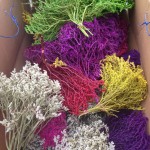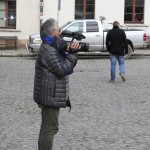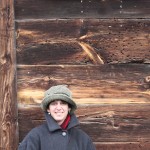[Today’s blog is written by Catherine Greenblatt. Cathy is part of the Chasing Portraits documentary film production team and has been with me in Poland for the past two weeks.]
At the turn of the 20th century, artists and writers from Warsaw and other Polish cities discovered the charm of Kazimierz Dolny, a village that lies on the Vistula River between Warsaw and Krakow. Kazimierz Dolny became a regular summer destination for artists, a colony or retreat where they could practice their craft without distraction. Artists visiting the town would stay with local families and participate in domestic life and rituals. Painters would paint in plein air; easels were set outside to catch the warm summer light, often capturing scenes of the marketplace, which still functions today, and the countryside, which remains beautiful, and the castle of King Kasimir, which still sits atop a hill at the end of the road leading from the market square. Moshe Rynecki was one of the many artists who regularly visited Kazimierz Dolny, and four of his watercolors of the town are carefully kept at ZIH (Jewish Historical Institute in Warsaw).
None of this would be terribly extraordinary, except for the fact that Kazimierz Dolny was not simply a picturesque town in the Polish countryside. Kazimierz Dolny was a shtetl, a small Jewish community that observed the traditional customs and practices of hasidic Jews, who composed 80% of the town’s population. It would have been, more than likely, into the houses of these Orthodox Jews that visiting artists and writers stayed; more than likely kosher food that they ate and shuttered shops that they encountered in the market square on Saturdays. The artists who visited Kazimierz Dolny, Jew and Pole alike, went there not simply to paint but to explore this other culture, which also became the subject matter of many paintings. When we visited the National Museum in Kazimierz Dolny, we had the pleasure of speaking with Director Agnieszka Zadura and former Director Waldemar Odorowski, who shed light on this complex topic. When Odorowski assembled a 2007 exhibition of Jewish painters for the museum there, he did quite a lot of research about the Jewish communities where artists like Moshe Rynecki lived and worked. He found that it was impossible to speak of a singular Jewish world of Warsaw. There were assimilated Jews who spoke Polish and lived in gentile neighborhoods; there were semi-assimilated Jews who spoke Yiddish and Hebrew at home but who did business with Poles; and there were Jews who lived and worked in Jewish neighborhoods exclusively; and there were Hasidic Jews who lived very traditional lives and did not engage at all in modernity. The artistic groups that emerged from these differing strata of interwar Jewish life had sharp differences, and each one would often work in exclusion to the others. Except in Kazimierz Dolny, where all of the usual differences would, at least for a time, give way to looser, more generous explorations.
- Self Portrait
The case of Moshe Rynecki is interesting: we know that he lived outside the Jewish quarters of Warsaw and spoke Polish. We also know that he was from a very religious Jewish family. He spoke or wrote Yiddish but also Russian, and his children learned German and Russian as well. Though he painted scenes of traditional Jewish life, in his self-portraits his image is that of an urban, worldly man, a modern European. The brush strokes of those self-portraits are stark and bold, expressive and contemporary. How do we make sense of this difference between his self-portraits and his depictions of traditional Jewish life, which are more lush and colorful and detailed?
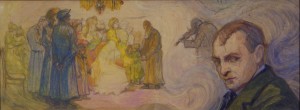 The self-portrait with wedding scene shows some of these dynamic qualities at work in Moshe’s imagination. There he is, in the lower right hand corner, confronting us with his gaze. The painter as self-conscious ethnographer. The majority of the canvas is given over to the wedding scene, an archetypal celebration in the life of Jewish family and community. The painting has two idioms, so to speak, one belonging to the painter and the other to the painted. Two cultures. Two separate spaces. Two identifications. And yet there they are, in the same frame finally, together making sense of what it is to be a Polish Jew.
The self-portrait with wedding scene shows some of these dynamic qualities at work in Moshe’s imagination. There he is, in the lower right hand corner, confronting us with his gaze. The painter as self-conscious ethnographer. The majority of the canvas is given over to the wedding scene, an archetypal celebration in the life of Jewish family and community. The painting has two idioms, so to speak, one belonging to the painter and the other to the painted. Two cultures. Two separate spaces. Two identifications. And yet there they are, in the same frame finally, together making sense of what it is to be a Polish Jew.
Elizabeth’s Corner… I thought you might enjoy some photos of our time at Kazimierz Dolny
